Dear Friends, Find the list of important Reasoning Test Questions 20-20 for upcoming SBI PO and competitive exams. We regularly provide 20 reasoning test questions daily for students. Aspirants practice these questions on a regular basis to improve your score in reasoning section. Aspirants preparing for the exams can make use of this 20-20 Reasoning Questions. SBI PO Prelims 2018 Notification has been released we hope you all have started your preparation. Here we have started New Series of Practice Materials specially for SBI PO Prelims 2018. Aspirants those who are preparing for the exams can use this “20-20” Reasoning Questions.
[WpProQuiz 2730]
Click “Start Quiz” to attend these Questions and view Explanation
Click here to view Reasoning Questions in Hindi
Direction (1-5): Read the following information carefully and answer the question given below.
Eight people A, B, C, D, E, F, G and H are sitting in the linear table all facing north, but not necessary to be in the same order.
Only one person sits between G and E. D sits second from the right end. H is an immediate neighbour of D. Only two people sits between H and A. Only two people sits between B and F, who is not an immediate neighbour of A. F is neither an immediate neighbour of G nor E. E and F are not an immediate neighbours. G does not sit to the immediate left of A.
1). Who among the following sits third to the right of E?
a) A
b) B
c) G
d) F
e) None of these
2). How many people sits between E and B?
a) One
b) Two
c) Three
d) More than Three
e) None
3). If all the people are made to sit in alphabetical order from left to right, then how many of them remains unchanged in their original position?
a) One
b) Two
c) Three
d) More than Three
e) None
4). Who among the following sits to the immediate left of G?
a) C
b) E
c) B
d) A
e) None of these
5). Which of the following statement is definitely true, based on the given arrangement?
a) Only one person sits between C and G.
b) D sits immediate right of F.
c) G sits immediate left of B.
d) A is not an immediate neighbour of E.
e) None of these
Direction (6-10): Study the given information and answer the questions:
A word and number arrangement machine when given an input line of words and numbers rearranges them following a particular rule in each step. The following is an illustration of an input and rearrangement.
Input: 24 affluent 87 nutrition 14 reductions 36 under 15 conceived
Step 1: 14 24 affluent 87 nutrition reductions 36 15 conceived under
Step 2: 24 14 affluent 87 nutrition 36 15 conceived under reductions
Step 3: 36 24 14 affluent 87 15 conceived under reductions nutrition
Step 4: 15 36 24 14 affluent 87 under reductions nutrition conceived
Step 5: 87 15 36 24 14 under reductions nutrition conceived affluent
And Step 5 is the last step of the rearrangement of the above input.
As per the rules followed in the above steps, find out in each of the following questions the appropriate step for the given input.
Input: 96 tackle 57 rising 12 overshot 53 urban 79 countries
6). Which of the following step will be last step for the given input?
a) Step 7
b) Step 6
c) Step 5
d) Step 3
e) None of these
7). How many words/numbers are between ‘overshot’ and ‘tackle’ in step 4?
a) One
b) Two
c) Three
d) More than Three
e) None
8). How many numbers are between “Overshot” and “Urban” in step 2?
a) One
b) Two
c) Three
d) More than Three
e) None
9). How many numbers/words between “12” and “rising” in step 5?
a) One
b) Two
c) Three
d) More than Three
e) None
10). Which of the following element is fifth from the right end in Step 3?
a) rising
b) overshot
c) 96
d) 79
e) None of these
Direction (11- 15): Read the following information carefully and answer the question given below.
A flower shop owner sold seven different flowers in a week. The week days started from Monday to Sunday. The flowers are namely Rose, Jasmine, Sunflower, Orchid, Daisy, Lily and Alyssum, but they all not necessary to be in the same order.
Alyssum flower was sold on Friday. Only one flower was sold between Rose and Lily. Orchid flower was sold immediately after Sunflower, which was not sold on first day of the week. Daisy is sold neither on Monday nor on Wednesday. Not more than two flowers were sold between Daisy and Jasmine flower, which was sold one of the day after Lily. Daisy flower is not sold any day before Rose. Not more than one flower was sold between Alyssum and Jasmine flower.
11). Jasmine flower was sold on which of the following days of the week?
a) Monday
b) Tuesday
c) Thursday
d) Saturday
e) None of these
12). How many flowers were sold after Sunflower was sold?
a) One
b) Two
c) Three
d) More than Three
e) None
13). How many flowers were sold between Daisy flower and Alyssum flower?
a) One
b) Two
c) Three
d) More than Three
e) None
14). Rose flower was sold on which of the following days of the week?
a) Monday
b) Tuesday
c) Thursday
d) Saturday
e) None of these
15). Which of the following flower is sold on Wednesday?
a) Lily
b) Rose
c) Jasmine
d) Orchid
e) None of these
Direction (16 – 18): Read the following information carefully and answer the question given below.
A stands 2meters north of B, who stand 1meter east of C. F stands 1meter north of E. D stands 2meters west of E. G stands 2meters north of H. F stands 3meters east of G. C stands 2meters north of D.
16). In which direction does G stands with respect to A?
a) North West
b) South West
c) North East
d) South East
e) None of these
17). In which direction does F stands with respect to D?
a) North West
b) South West
c) North East
d) South East
e) None of these
18). If U stands 2 meter east of H. Then what is the distance between A and U?
a) 7m
b) 5m
c) 6m
d) 8m
e) None of these
Direction (19 – 20): Read the following information carefully and answer the question given below.
Seven people A, B, C, D, E, F and G are in the family. There are two married couple and three generations in the family. Number of males in the family is one more than number of females in the family.
A is the mother of C and Daughter-in-law of F. B is the father of D, who is the nephew of G. F has only one daughter and one son. F has only one grandson. F is the father of G, who has only one daughter. There is no sibling in third generation.
19). How is A related to E?
a) Brother
b) Father
c) Sister in law
d) Cannot be determined
e) None of these
20). How is A related to D?
a) Uncle
b) Aunt
c) Daughter-in-law
d) Nephew
e) None of these
Answers:
Direction (1-5):
Explanation:
i). Only one person sits between G and E.
ii). D sits second from the right end.
iii). H is an immediate neighbour of D.
iv). Only two people sits between H and A.
v). Only two people sits between B and F, who is not an immediate neighbour of A.
vi). F is neither an immediate neighbour of G nor E.
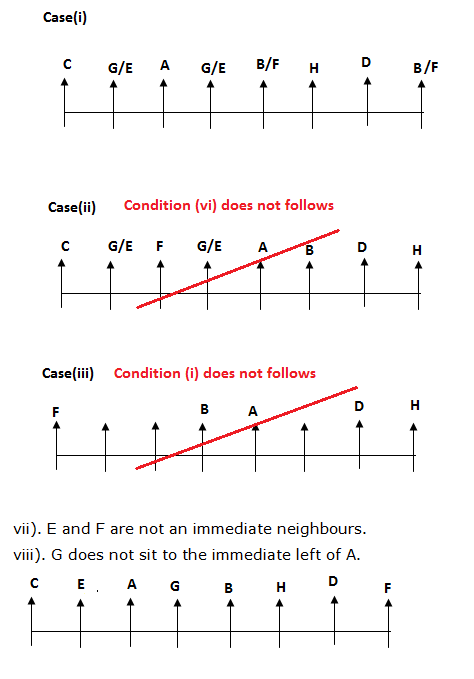
1.Answer: B
2.Answer: B
3.Answer: E
4.Answer: D
5.Answer: C
Direction (6-10):
6.Answer: C
Explanation:
Input: 96 tackle 57 rising 12 overshot 53 urban 79 countries
Step 1: 12 96 tackle 57 rising overshot 53 79 countries urban
Step 2: 96 12 57 rising overshot 53 79 countries urban tackle
Step 3: 53 96 12 57 overshot 79 countries urban tackle rising
Step 4: 57 53 96 12 79 countries urban tackle rising overshot
Step 5: 79 57 53 96 12 urban tackle rising overshot countries
7.Answer: A
Explanation:
Input: 96 tackle 57 rising 12 overshot 53 urban 79 countries
Step 1: 12 96 tackle 57 rising overshot 53 79 countries urban
Step 2: 96 12 57 rising overshot 53 79 countries urban tackle
Step 3: 53 96 12 57 overshot 79 countries urban tackle rising
Step 4: 57 53 96 12 79 countries urban tackle rising overshot
Step 5: 79 57 53 96 12 urban tackle rising overshot countries
8.Answer: B
Explanation:
Input: 96 tackle 57 rising 12 overshot 53 urban 79 countries
Step 1: 12 96 tackle 57 rising overshot 53 79 countries urban
Step 2: 96 12 57 rising overshot 53 79 countries urban tackle
Step 3: 53 96 12 57 overshot 79 countries urban tackle rising
Step 4: 57 53 96 12 79 countries urban tackle rising overshot
Step 5: 79 57 53 96 12 urban tackle rising overshot countries
9.Answer: B
Explanation:
Input: 96 tackle 57 rising 12 overshot 53 urban 79 countries
Step 1: 12 96 tackle 57 rising overshot 53 79 countries urban
Step 2: 96 12 57 rising overshot 53 79 countries urban tackle
Step 3: 53 96 12 57 overshot 79 countries urban tackle rising
Step 4: 57 53 96 12 79 countries urban tackle rising overshot
Step 5: 79 57 53 96 12 urban tackle rising overshot countries
10.Answer: D
Explanation:
Input: 96 tackle 57 rising 12 overshot 53 urban 79 countries
Step 1: 12 96 tackle 57 rising overshot 53 79 countries urban
Step 2: 96 12 57 rising overshot 53 79 countries urban tackle
Step 3: 53 96 12 57 overshot 79 countries urban tackle rising
Step 4: 57 53 96 12 79 countries urban tackle rising overshot
Step 5: 79 57 53 96 12 urban tackle rising overshot countries
Direction (11- 15):
Explanation:
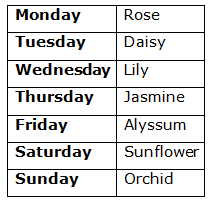
i). Alyssum flower was sold on Friday.
ii). Only one flower was sold between Rose and Lily.
iii). Orchid flower was sold immediately after Sunflower, which was not sold on first day of the week.
iv). Daisy is sold neither on Monday nor on Wednesday.
v). Not more than two flowers were sold between Daisy and Jasmine flower, which was sold one of the day after Lily.
vi). Daisy flower is not sold any day before Rose.
vii). Not more than one flower was sold between Alyssum and Jasmine flower.
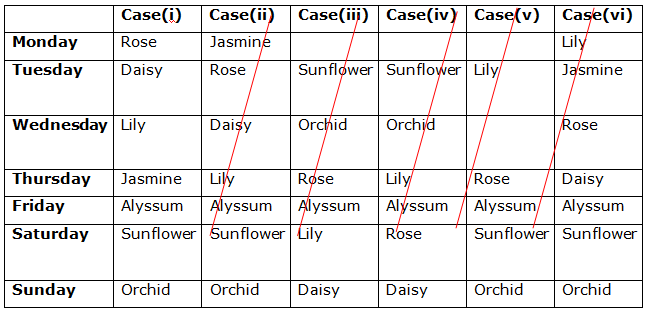
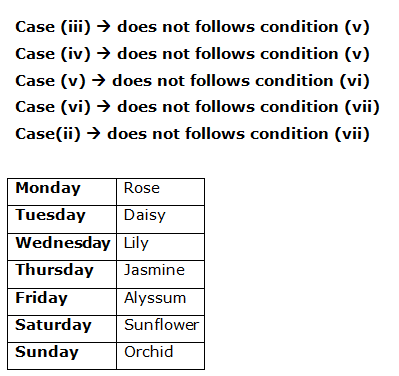
11.Answer: C
12.Answer: A
13.Answer: B
14.Answer: A
15.Answer: A
Direction (16 – 18):
Explanation:

16.Answer: B
17.Answer: C
18.Answer: B
Direction (19 – 20):
Explanation:
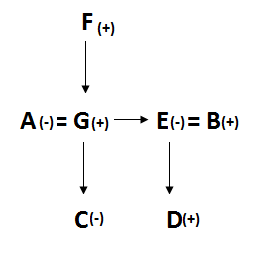
19.Answer: C
20.Answer: B
Daily Practice Test Schedule | Good Luck
| Topic | Daily Publishing Time |
| Daily News Papers & Editorials | 8.00 AM |
| Current Affairs Quiz | 9.00 AM |
| Quantitative Aptitude “20-20” | 11.00 AM |
| Vocabulary (Based on The Hindu) | 12.00 PM |
| General Awareness “20-20” | 1.00 PM |
| English Language “20-20” | 2.00 PM |
| Reasoning Puzzles & Seating | 4.00 PM |
| Daily Current Affairs Updates | 5.00 PM |
| Data Interpretation / Application Sums (Topic Wise) | 6.00 PM |
| Reasoning Ability “20-20” | 7.00 PM |
| English Language (New Pattern Questions) | 8.00 PM |





